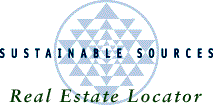
|

|
 |
Buy or Sell your Green Built Home through the Sustainable Sources Real Estate Locator! |
Wood treatment refers to protecting wood from damage caused by insects, moisture, and decay fungi.
Three primary methods of wood treatment currently prevail: creosote pressure-treated wood, pentachlorophenol pressure-treated wood, and inorganic arsenical pressure-treated wood. The pressure-treating process is done by commercial facilities and made available to users in the final wood product. Copper napthenate, zinc napthenate, and tributyltin oxide are other wood treatment options that can be site applied. All of these treatment processes involve dangerous chemicals .
Chromated copper arsenate (CCA) is the most popular wood treatment product available today. The chemicals are inert within the material and offer protection from moisture and decay fungi. The chemicals do not penetrate into the heartwood effectively so a sealer is advisable on cut ends of CCA treated wood. Although CCA treated wood is sawn on jobsites, hardly anyone seals the cuts. All pressure treated products require adherence to safety precautions approved by the EPA. The safety precautions are listed in the Guidelines section.
EPA regulations govern the manufacture of pressure-treated materials and require extensive environmental safety precautions. Wood treatment does offer a method to extend the usable life of our wood resources.
The toxicity of the chemicals used in wood treatment has led to research into less toxic methods such as the use of borates derived from the natural element boron (borax). Borates (from boron) are used in wood in New Zealand and Australia and offer insect protection and fire retarding benefits to wood. Full-scale commercial introduction of borates in the U.S. awaits resolution of the leaching problem of borates. Since borates are water soluble, water dilutes them and leaves the wood unprotected from decay after a period of time. In a location unexposed to water, they are effective in preserving wood; site applied borate products are available.
Borate pressure-treated wood is being offered by one company in the U.S. (primarily for the Caribbean market). They are promoting the concept of using borates for all the wood in a house. This eliminates the need for termite protection by any other means and prevents decay fungi.
Ammoniacal copper quatenary (ACQ) is a new wood preservative currently being
introduced. This material employs preservative components that are listed in EPA's
classification as "General Use" pesticides. This is a less toxic material that CCA and it performs similarly.
Wood pressure-treated with waterborne arsenical preservatives may be used inside residences as long as all sawdust and construction debris are cleaned up and disposed of after construction.
Texas Forest Service
Texas Forest Service
Sinan Company
Chemical Specialties Inc. (CSI)
NISUS CORPORATION
U.S. Borax and Chemical Corp.
Caribbean Lumber Co.
The American Wood Preservers Institute
American Forest and Paper Association (formerly The National Forest Products Association)
The Bio-Integral Resource Center
The American Wood-Preservers' Association
Environmental Buildng News reviews treated wood
return to
Table of Contents
Sustainable Building Sourcebook web version copyright Sustainable
Sources 1994-1999.
CONSIDERATIONS:
Commercial
Status
Implementation
Issues
![]()
![]()
![]()
![]()
![]()
![]()
Wood Treatment
![]()
![]()
![]()
![]()
![]()
![]()
Legend
![]()
Satisfactory
![]()
Satisfactory in most conditions
![]()
Satisfactory in Limited Conditions
![]()
Unsatisfactory or Difficult
COMMERCIAL STATUS
TECHNOLOGY:
Borate treatment is not technologically mature in comparison with CCA treated wood. Leaching problems must be resolved for borate treatment to substitute for CCA pressure-treated wood.
SUPPLIERS:
Suppliers of site-applied borate products are uncommon. Commercial application of borate treatment is just becoming available.
COST:
Site-applied borate treatments exceed the cost of other chemical treatments due to shipping costs. Borate pressure-treated material adds about $2,500 to the costs of an average sized frame house.
IMPLEMENTATION ISSUES
FINANCING:
Available if the borate treatment is code compliant.
PUBLIC ACCEPTANCE:
There is not widespead awareness of borate treatment. However, reduced health risk should be seen as a positive characteristic.
REGULATORY:
Any wood within 6 inches of the finish grade must be factory treated or have natural resistance (e. g. heartwood of cedar, redwood, or black locust). (See also
Non-toxic Termite Control)
GUIDELINES
RESOURCES
PROFESSIONAL ASSISTANCE
Southern Forest Experiment Station
Forest Sciences Lab
P. O. Box 906
Starkville, MS 39759
(601) 324-1611
Texas A&M University
100 Research Parkway
College Station, TX 77843-2136
(409) 845-8575
Forest Products Lab
P. O. Box 310, Hwy 59 South
Lufkin, TX 75901
(409) 639-8180
COMPONENTS / MATERIALS / SYSTEMS
Pressure treated materials are commonly available at all building material outlets
Borate products
Eco-Wise
1714-A South Congress
Austin, TX 78704
(512) 326-5353
Auro products
P. O. Box 857
Davis, CA 95617-0857
(916) 753-3104
Auro products
One Woodlawn Green 250
Charlotte, NC 28217
(800) 421-8661
Impel Rods, ACQ
215 Dunavant Drive
Rockford, TN 37853
(800) 264-0870
Bora-Care(TM)
3075 Wilshire Blvd.
Los Angeles, CA 90010-1294
(213) 251-5400
Tim-Bor
P. O. Box 2687
Savannah, GA 31498-2687
(912) 748-7800
borate pressure-treated lumber
GENERAL ASSISTANCE:
Southern Forest Products Association
Treated and Residential Markets Manager
P. O. Box 641700
Kenner, LA 70064-1700
(504) 443-4464
www.sfpa.com
2750 Prosperity Ave., Suite 550
Fairfax, VA 22031-4312
703-204-0500
www.awpi.org
1111 19th St., NW, Suite 800
Washington, DC 20036
202-463-2700
www.afandpa.org
P. O. Box 7414
Berkeley, CA 94707
(415) 524-2567
3246 Fall Creek Highway, Suite 190
Granbury, TX 76049
817-326-6300
www.cssinfo.com/info/awpa.html
INTERNET RESOURCES
Treated Wood: Is it Safe? by Andrew MacMillen
This document was adapted to HTML by Bill
Christensen, sysop and environmental editor of Texas InfiNet, an online
community for progressive information.